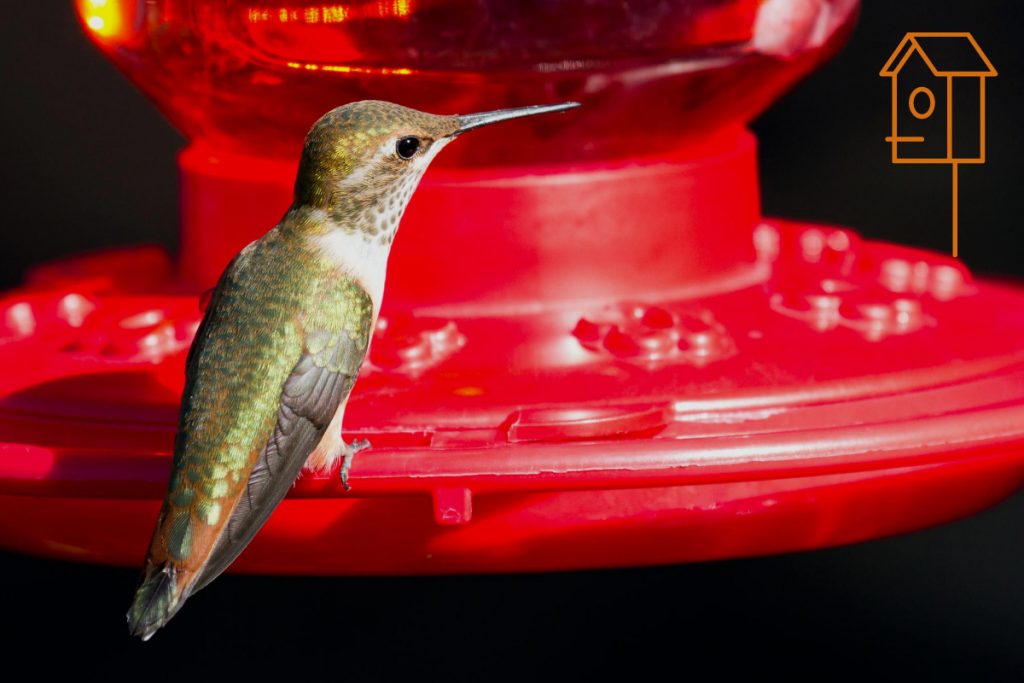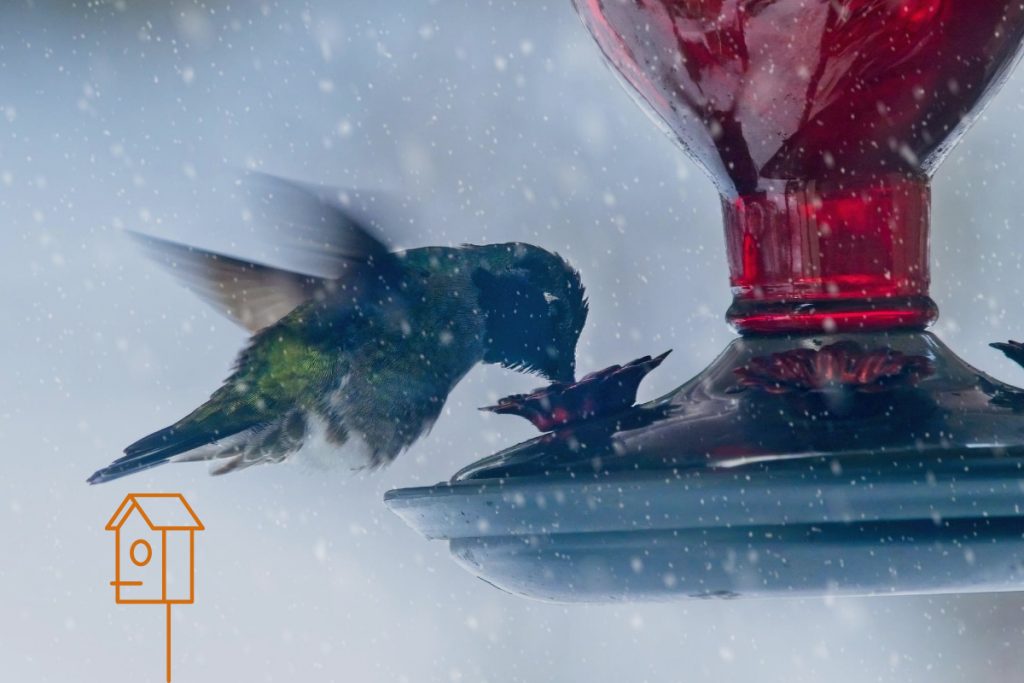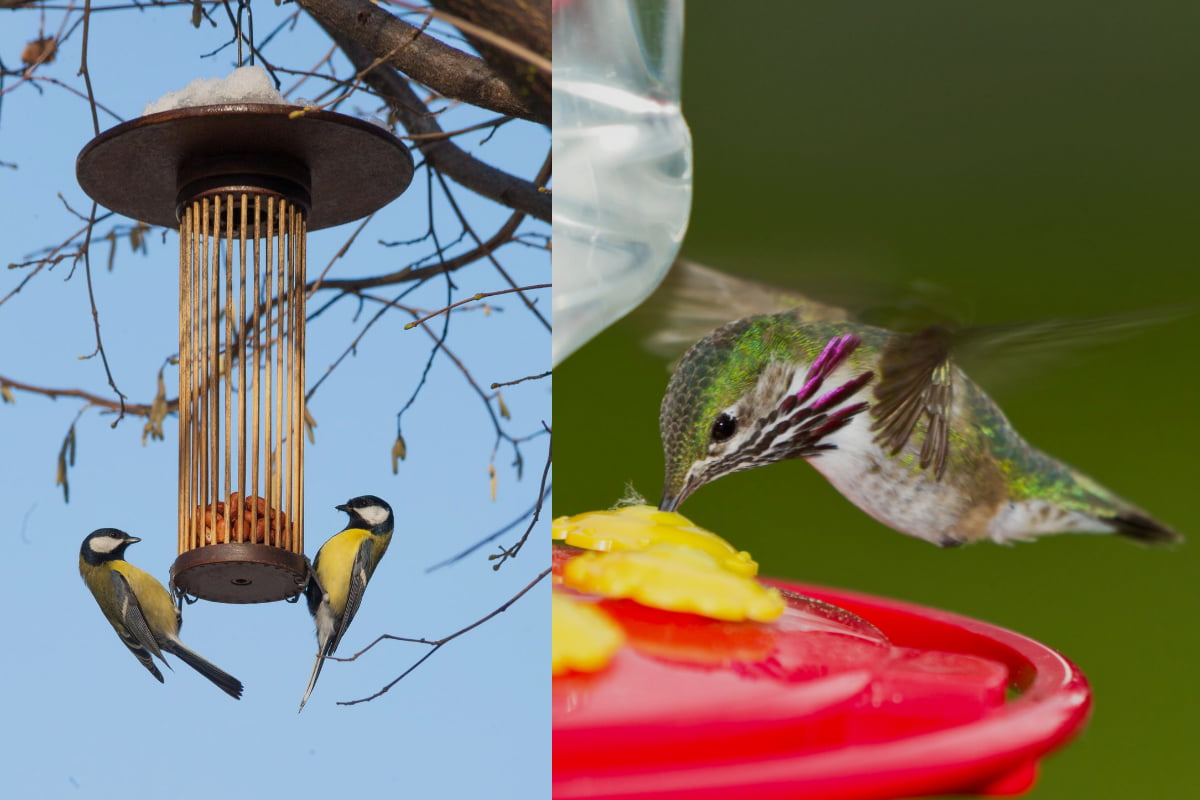Yes, you can absolutely hang a hummingbird feeder alongside other bird feeders in your garden. However, it’s important to maintain proper spacing between feeders to prevent territorial disputes and competition.
Hummingbirds, despite their bold flying abilities, can be easily intimidated by larger birds. For best results, place hummingbird feeders at least 10-15 feet away from other types of bird feeders and in a quieter area of your garden.
Hummingbirds are truly one of nature’s most fascinating creatures. These tiny, iridescent birds with their incredible hovering abilities can bring so much joy to any garden. If you’re already feeding other wild birds, you might wonder if adding a hummingbird feeder to your setup is a good idea. With some thoughtful planning and understanding of bird behavior, you can create a harmonious environment that welcomes both hummingbirds and other feathered visitors.
Key Takeaways:
- Yes, you can hang hummingbird feeders with other bird feeders, but proper spacing of 10-15 feet is essential for the comfort and safety of hummingbirds.
- Hummingbirds are territorial and easily intimidated by larger birds, so placing their feeders in quieter, more secluded areas will encourage more frequent visits.
Related Post: What Is Hummingbirds?

Why Proper Spacing Matters for Hummingbird Feeders
Hummingbirds may be small, but they have big personalities! These tiny birds are naturally territorial, especially around food sources. When you place their feeders too close to other bird feeding stations, several problems can arise:
Competition for Food
Larger birds can easily dominate a feeding area, making hummingbirds hesitant to approach. Even though hummingbird feeders have specialized ports that only accommodate their thin beaks, the presence of larger birds nearby can be intimidating.
Stress and Territorial Behavior
Hummingbirds expend tremendous energy throughout the day. When they have to constantly defend their feeding territory from perceived threats, it causes unnecessary stress and wastes precious energy they need for survival.
Reduced Visits
If hummingbirds don’t feel safe at your feeder, they’ll simply find another food source. You might notice fewer visits or none at all if your feeder placement causes them stress.
A good rule of thumb is to maintain at least 10-15 feet between your hummingbird feeder and any other bird feeding stations. This distance gives hummingbirds their own space while still allowing you to enjoy a variety of bird species in your garden.
Best Practices for Hanging Hummingbird Feeders
To create the perfect environment for hummingbirds while still accommodating other birds, follow these helpful tips:
1. Strategic Placement
Position your hummingbird feeder in a quieter area of your garden, preferably near flowering plants that naturally attract hummingbirds. This creates a comfortable, familiar environment that feels safe to them. Ideally, place the feeder:
- Near windows where you can easily observe them (but not so close that window collisions become a risk)
- At least 10-15 feet from other bird feeders
- Away from high-traffic areas in your garden
- Within 10-15 feet of trees or shrubs that provide quick shelter.
2. Provide Multiple Feeding Stations
If you have the space and resources, consider setting up multiple hummingbird feeders in different locations around your garden. This reduces competition among hummingbirds themselves, as they can be territorial even with their own kind.
3. Create Visual Barriers
Using plants or garden features to create visual barriers between different types of feeders can help reduce territorial disputes. If birds can’t see each other, they’re less likely to feel threatened.
4. Offer Perching Opportunities
While hummingbirds are famous for hovering while they feed, they actually spend most of their time perching. Choose a feeder with built-in perches or ensure there are small branches nearby where they can rest between feeding sessions.

Maintaining Your Hummingbird Feeder
Proper maintenance is crucial for keeping hummingbirds healthy and encouraging return visits:
Regular Cleaning
Clean your hummingbird feeder thoroughly every 3-5 days, especially during hot weather. Mold and bacteria can grow quickly in sugar water and cause serious illness in hummingbirds.
Fresh Nectar Solution
Use a simple solution of 1 part white granulated sugar to 4 parts water. Avoid using honey, brown sugar, artificial sweeteners, or red food colouring, as these can be harmful to hummingbirds.
Protect from Ants and Bees
Use ant moats and bee guards to keep insects away from your feeder. These simple additions can make a big difference in keeping the nectar clean and accessible only to hummingbirds.
Different Types of Bird Feeders and Their Compatibility
Understanding the different types of bird feeders and how they interact is helpful when planning your garden bird feeding stations:
| Feeder Type | Bird Species | Compatibility with Hummingbird Feeders |
|---|---|---|
| Nectar Feeders | Hummingbirds, orioles | Can be placed near each other |
| Seed Feeders | Finches, cardinals, sparrows | Keep 10-15 feet away from hummingbird feeders |
| Suet Feeders | Woodpeckers, nuthatches | Keep 10-15 feet away from hummingbird feeders |
| Platform Feeders | Various ground-feeding birds | Keep at least 15 feet away from hummingbird feeders |

Common Mistakes to Avoid
When adding a hummingbird feeder to your existing bird feeding setup, watch out for these common pitfalls:
Placing Feeders Too Close Together
This is the most common mistake and can result in fewer hummingbird visits. Remember the 10-15 foot rule for optimal spacing.
Using the Wrong Recipe
Only use a simple sugar-water solution (1:4 ratio). Never add red dye, honey, or artificial sweeteners, which can harm hummingbirds.
Inconsistent Maintenance
Dirty feeders can spread disease and discourage visits. Set a regular cleaning schedule and stick to it.
Placing Feeders in High-Traffic Areas
Hummingbirds prefer quieter, more secluded spots. Avoid placing their feeders near busy patios or walkways.
Creating a Bird-Friendly Garden
To make your garden truly inviting for both hummingbirds and other bird species, consider these additional tips:
Plant Native Flowers
Include plants that naturally produce nectar, such as bee balm, salvia, and trumpet vine. These provide natural food sources and attract more hummingbirds to your garden.
Provide Water Sources
Bird baths and small fountains attract a variety of birds. Hummingbirds particularly enjoy moving water and will sometimes bathe in the spray from a gentle fountain.
Offer Shelter
Dense shrubs and trees provide places for birds to hide from predators and build nests. Different bird species prefer different types of shelter, so variety is key.
Avoid Pesticides
Chemicals can harm birds directly or reduce the insect population they rely on for protein. Use natural pest control methods whenever possible.
Final Thoughts
Creating a garden that welcomes both hummingbirds and other bird species is absolutely possible with some thoughtful planning. By understanding the unique needs of hummingbirds and respecting their territorial nature, you can create a balanced ecosystem where all birds feel welcome.
Remember that proper spacing between feeders, regular maintenance, and creating natural habitats are the keys to success. The extra effort is well worth it when you’re rewarded with the magical sight of hummingbirds darting around your garden while other bird species happily feed nearby.
Have you tried hanging hummingbird feeders alongside other bird feeders in your garden?
What techniques have worked best for attracting these fascinating little birds? Share your experiences to help fellow bird enthusiasts create their own bird-friendly havens!
Frequently Asked Questions (FAQs about hanging hummingbird feeders with other bird feeders).
Q: How far should a hummingbird feeder be from other bird feeders?
A: Place hummingbird feeders at least 10-15 feet away from other bird feeders. This spacing helps reduce competition and stress for hummingbirds, who can be intimidated by larger birds despite their bold flying abilities.
Q: Can I use the same food in all my bird feeders?
A: No. Hummingbird feeders require a specific sugar-water solution (1 part white sugar to 4 parts water), while other birds need seeds, nuts, or suet. Never put seed in a hummingbird feeder or sugar water in a seed feeder.
Q: How often should I clean my hummingbird feeder?
A: Clean your hummingbird feeder every 3-5 days, especially during hot weather when bacteria and mold grow quickly. Regular cleaning prevents the spread of harmful diseases among hummingbirds.
Q: Why aren’t hummingbirds visiting my feeder?
A: Several factors could be at play: your feeder might be too close to other bird feeders, the nectar could be old or fermented, the feeder might be placed in a high-traffic area, or it might be the wrong time of year for hummingbirds in your region.
Q: Is it normal for hummingbirds to fight at feeders?
A: Yes, hummingbirds are naturally territorial, especially males. If you notice aggressive behavior, try adding multiple feeders in different locations around your garden to reduce competition.
Q: Should I take down my hummingbird feeder in winter?
A: This depends on your location. In areas where hummingbirds migrate, you can take down feeders about two weeks after the last sighting. In regions with year-round hummingbird populations, keep feeders up all year but be extra vigilant about keeping the nectar from freezing.
Q: What color hummingbird feeder is best?
A: Red is typically most effective at attracting hummingbirds, as they’re naturally drawn to this color which often signals nectar-rich flowers in nature. However, once hummingbirds find your feeder, the color becomes less important than consistent food availability.
References: Hummingbirds, Bird Feeders.
